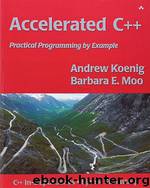Accelerated C++: Practical Programming by Example by Andrew Koenig & Barbara E. Moo

Author:Andrew Koenig & Barbara E. Moo [Koenig, Andrew & Moo, Barbara E.]
Language: eng
Format: epub
Tags: C, Programming Languages, Computers, Programming, General, C++ (Computer Program Language), C Plus Plus (Computer Program Language)
ISBN: 9780201703535
Google: OaVQAAAAMAAJ
Amazon: 020170353X
Barnesnoble: 020170353X
Publisher: Addison-Wesley
Published: 2000-08-01T07:00:00+00:00
As it stands, our Student_info class is in this third category: It is a class type, but we do not explicitly say how to construct Student_info objects. So, if we define a local Student_info variable, then the n and homework members will be automatically initialized to the empty string and vector respectively, because they are class objects with constructors. In contrast, default-initializing midterm and final will give them undefined values, meaning they will hold whatever garbage happens to be in memory when the object is created.
Given our simple operations, this behavior may appear harmless: None of our operations uses the value of midterm or final without first initializing the object by calling read, which assigns values to these members. However, it is normally good practice to ensure that every data member has a sensible value at all times. For example, it is possible that later we (or a subsequent maintainer of our code) will add operations that examine these data members. If we don't initialize them in the constructor, then these new operations might cause future failures. Moreover, as we'll see in §11.3.5/201, even though we do not explicitly use midterm or final, there are synthesized operations on the class that could do so. Any use other than writing to an undefined value is illegal (§3.1/38), and so, strictly speaking, we must initialize these values.
In practice, we'll want to define two constructors: The first constructor takes no arguments and creates an empty Student_info object; the second takes a reference to an input stream and initializes the object by reading a student record from that stream. This strategy allows our users to write code such as
Student_info s; // an empty Student_info Student_info s2(cin); // initialize s2 by reading from cin
Download
This site does not store any files on its server. We only index and link to content provided by other sites. Please contact the content providers to delete copyright contents if any and email us, we'll remove relevant links or contents immediately.
Sass and Compass in Action by Wynn Netherland Nathan Weizenbaum Chris Eppstein Brandon Mathis(13266)
Implementing Enterprise Observability for Success by Manisha Agrawal and Karun Krishnannair(8233)
Supercharging Productivity with Trello by Brittany Joiner(7481)
Mastering Tableau 2023 - Fourth Edition by Marleen Meier(7231)
Inkscape by Example by István Szép(7121)
Visualize Complex Processes with Microsoft Visio by David J Parker & Šenaj Lelić(6803)
Build Stunning Real-time VFX with Unreal Engine 5 by Hrishikesh Andurlekar(5830)
Design Made Easy with Inkscape by Christopher Rogers(5088)
Customizing Microsoft Teams by Gopi Kondameda(4636)
Business Intelligence Career Master Plan by Eduardo Chavez & Danny Moncada(4589)
Extending Microsoft Power Apps with Power Apps Component Framework by Danish Naglekar(4229)
Salesforce Platform Enterprise Architecture - Fourth Edition by Andrew Fawcett(4112)
Pandas Cookbook by Theodore Petrou(4088)
Linux Device Driver Development Cookbook by Rodolfo Giometti(4052)
The Tableau Workshop by Sumit Gupta Sylvester Pinto Shweta Sankhe-Savale JC Gillet and Kenneth Michael Cherven(3890)
Exploring Microsoft Excel's Hidden Treasures by David Ringstrom(3392)
TCP IP by Todd Lammle(3157)
Applied Predictive Modeling by Max Kuhn & Kjell Johnson(3043)
Drawing Shortcuts: Developing Quick Drawing Skills Using Today's Technology by Leggitt Jim(3040)
